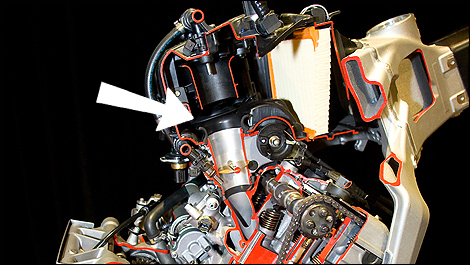Building the safest bike on the market involved the development of several highly sophisticated electronic features, then making them work together (“Integration” in software terms) in a coherent fashion.
The BMW developers and testers created four different riding modes (Rain, Sport, Race and Slick), and fine tuned the systems to adapt them to the performance and safety levels required for each mode.
Our first track ride on the S1000RR allowed us to validate these features in three of the four modes, as I personally left the “Slick” Mode to racers. Describing and riding the bike made for a separate article.
Describing all the electronics on the S1000RR and how they work is involved enough to justify this separate paper, together with cross references between the ride report and this document, to facilitate reading and comprehension.
Here are descriptions of the various systems at work to optimize performance and safety, and the benefits thereof. The various on-board computers will be referred to collectively as the Engine Control Unit (ECU) to simplify the text.
Variable length intake trumpets
Low frequency sounds and resonance are associated with long conduits, while high frequencies are associated with shorter ones. For example, a trumpet (High notes) is shorter than a slide trombone (Low notes).
The intake side of a four stroke engine takes advantage of the pulses, created by the opening and closing of the intake valves, to create synchronized waves of incoming air that are used to “supercharge” the cylinder with air on the intake stroke. A long intake trumpet does this nicely under 6000rpm (Good for torque), while a shorter trumpet works better from there to maximum rpm (Good for power).
This length change is accomplished by installing long two-piece intake trumpets and programming the Engine Control Unit (ECU) to separate the extra length when the rpm goes over a certain limit.
 |
| The arrow shows the lower, fixed short intake stack. The extension is poised above it, waiting for the ECU to tell it to go down and mate with the base, to favour low rpm flow, and thus torque. |
This feature provides for a fatter and more constant torque output, over a longer rev range. Torque also remains higher at very low and very high rpm, to produce more power across the whole rev range.
Throttle by Wire
The throttle wire coming from the twist grip actuates a sensor that sends the signal from your wrist to the ECU for processing. This signal is then combined with other sensor inputs regarding the engine, temperatures, lateral and longitudinal lean angles, and wheel speed sensors.
Based on all this information, the ECU then activates the intake butterflies and sets timing and fuel injection flow and timing. It does not stop there, as it also manages several other functions. Here are a few of them.
Power setting – The ECU controls power output, producing 153hp in Rain Mode and 193 in the other three modes (200 at 100kph when ram air takes effect), thereby adapting power to the riding conditions and rider preference.

